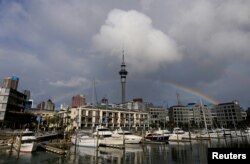A landmark 11-member trade deal aimed at slashing barriers in some of Asia Pacific's fastest growing economies will come into force at the end of December, the New Zealand government said on Wednesday.
The deal would move forward after Australia informed New Zealand that it had become the sixth nation to formally ratify the deal, alongside Canada, Japan, Mexico and Singapore.
"This triggers the 60 day countdown to entry into force of the Agreement and the first round of tariff cuts," said New Zealand Trade and Export Growth Minister David Parker. His country is responsible for official tasks such as receiving and circulating notifications made by members of the pact.
The original 12-member deal was thrown into limbo early last year when President Donald Trump withdrew from the agreement to prioritize protecting U.S. jobs.
The 11 remaining nations, led by Japan, finalized a revised trade pact in January, called the Comprehensive and Progressive Agreement for Trans-Pacific Partnership (CPTPP).
The success of the deal has been touted by officials in Japan and other member countries as an antidote to counter growing U.S. protectionism, and with the hope that Washington would eventually sign back up.
Australia said the agreement will boost agricultural exports, set to be worth more than A$52 billion ($36.91 billion) this year despite a crippling drought across much of the country's east coast.
"It will give Australian grain farmers a good reason to smile, at a time when drought conditions have played havoc for many, by ensuring improved market access and better grain prices once more favorable seasonal conditions return," said Luke Mathews, trading and economics manager at industry body, GrainGrowers Australia.
The deal will reduce tariffs in economies that together amount to more than 13 percent of global GDP — a total of $10 trillion. With the United States, it would have represented 40 percent.
The five member countries still to ratify the deal are Brunei, Chile, Malaysia, Peru and Vietnam.













